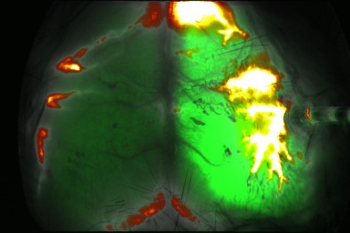In a new article in Science, a mathematical model from DTU is used to explain how fluid can build up in the brain in mice after a stroke.
New research results from murine studies just published in Science now show—for the first time—that the glymphatic system, which is normally responsible for eliminating toxins and accumulated proteins from the brain, causes brain oedema after a stroke, resulting in suffocation of brain cells.
The group behind the article includes researchers from the University of Copenhagen, DTU, and the University of Rochester Medical Center in the United States. In 2012, researchers from the University of Copenhagen and the University of Rochester Medical Center discovered the glymphatic system—a network that utilizes the brain’s blood circulation. The system consists of several perivascular ‘tunnels’ that are surrounded by a layer of vascular walls. Cerebrospinal fluid (CSF) runs between these two layers. The system pumps the fluid through the brain tissue, primarily during sleep, and it flushes away toxic proteins and other waste products.
However, the glymphatic system also plays a role in the brain oedema that occurs after a stroke, as shown in the new study that is based on experimental murine studies and supported by mathematical modelling.
Electric wave before flooding
The most common type of stroke is ischemic stroke, and it occurs when a blood vessel in the brain becomes blocked. As this prevents the brain cells from getting the nutrients and oxygen they need to function, they quickly become compromised and expand—a phenomenon known as cytotoxic oedema.
In an attempt to survive, the neurons depolarize and release their energy reserves. When the cells release this energy, the effect spreads to neighbouring cells, resulting in a domino effect with an electric wave that emanates from the stroke’s original position in the brain.
During this spreading depolarization, the neurons release large amounts of potassium in the brain. The increased concentration of potassium causes the muscle cells making up the walls around the blood vessels to contract.
These processes have been observed in an experimental setting and are part of a mathematical model developed at DTU Compute by MSc student Peter A. R. Bork, Associate Professor Poul G. Hjorth, and Associate Professor Erik A. Martens.
“Cerebrospinal fluid flows into the vacuum that occurs and floods the brain tissue, causing even more tissue damage. The already fragile brain cells are sort of drowning in the cerebrospinal fluid. The experimental observations can be explained on a mechanistic basis using the mathematical model, which also shows that depolarization waves can continue in the brain for days, or even weeks after the stroke, and exacerbate the problem,” says Erik A. Martens.


Top: The ischemic depolarization wave is experimentally visualized with fluorescence and spreads from the blockage across the surface of the brain (green). This is followed by an influx of fluid in the brain (red, yellow, and white). Bottom: An illustration of the mathematical modelling of the same processes, which is consistent with the observations made during the experiment and also takes into account the structure of the glymphatic vessel that follows the blood vessel network.
Mathematical modelling creates cohesion
“Mathematical modelling is a key part of this type of research because it helps combine various mechanisms observed in experiments into one cohesive image. Cause and effect are connected, so that hypotheses can be checked,” says Erik A. Martens.
“And through fundamental principles from fluid physics, dynamic systems, and network theory, we have tried to describe the simplest mechanism consistent with what was observed by the medical professionals. This showcases the benefits and potential of combining biology and medicine with mathematics and biophysics,” adds Poul G. Hjorth.
Peter A. R. Bork, who participated in the project as part of his Master’s project at DTU, also sees synergies between the different research areas of the project:
“It’s exciting to see mathematical models, which are often considered to be very abstract, literally come to life. It has been really fascinating to get so close to the research front with my Master’s project in mathematical modelling at DTU."
May pave the way for new treatment strategies
The new findings could pave the way for new treatment strategies to be used in combination with existing therapies that focus on normalising blood flow after a stroke, and possibly for other disorders as well, such as traumatic injuries.
Treatments that block specific receptors on nerve cells could potentially inhibit the spread of depolarization. Furthermore, the influx of cerebrospinal fluid is controlled by the water channels on astrocytes—an important supporting cell. When the research team conducted the murine study, they could inhibit these water channels and significantly reduce the flow of cerebrospinal fluid.
Drugs that can affect these water channels are already being developed as a treatment for cardiac arrest, and they could potentially also turn out to be effective against stroke. However, more studies are needed to understand how and whether the results of this study are applicable to humans so that the therapies used today can be improved.